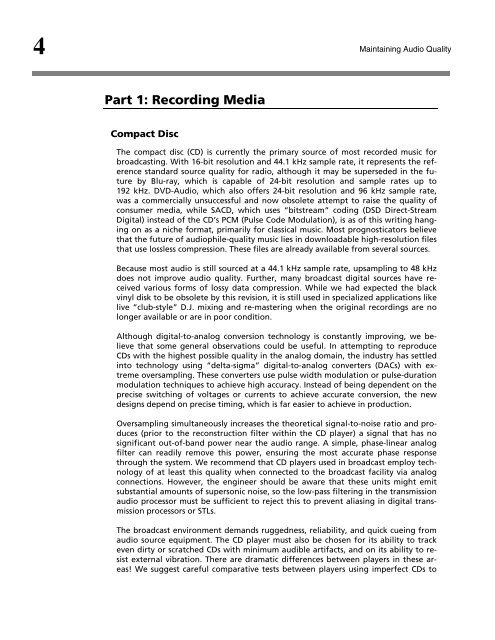Maintaining Audio Quality in the Broadcast Facility 2011 - Orban
Maintaining Audio Quality in the Broadcast Facility 2011 - Orban
Maintaining Audio Quality in the Broadcast Facility 2011 - Orban
You also want an ePaper? Increase the reach of your titles
YUMPU automatically turns print PDFs into web optimized ePapers that Google loves.
4<br />
Part 1: Record<strong>in</strong>g Media<br />
Compact Disc<br />
<strong>Ma<strong>in</strong>ta<strong>in</strong><strong>in</strong>g</strong> <strong>Audio</strong> <strong>Quality</strong><br />
The compact disc (CD) is currently <strong>the</strong> primary source of most recorded music for<br />
broadcast<strong>in</strong>g. With 16-bit resolution and 44.1 kHz sample rate, it represents <strong>the</strong> reference<br />
standard source quality for radio, although it may be superseded <strong>in</strong> <strong>the</strong> future<br />
by Blu-ray, which is capable of 24-bit resolution and sample rates up to<br />
192 kHz. DVD-<strong>Audio</strong>, which also offers 24-bit resolution and 96 kHz sample rate,<br />
was a commercially unsuccessful and now obsolete attempt to raise <strong>the</strong> quality of<br />
consumer media, while SACD, which uses “bitstream” cod<strong>in</strong>g (DSD Direct-Stream<br />
Digital) <strong>in</strong>stead of <strong>the</strong> CD’s PCM (Pulse Code Modulation), is as of this writ<strong>in</strong>g hang<strong>in</strong>g<br />
on as a niche format, primarily for classical music. Most prognosticators believe<br />
that <strong>the</strong> future of audiophile-quality music lies <strong>in</strong> downloadable high-resolution files<br />
that use lossless compression. These files are already available from several sources.<br />
Because most audio is still sourced at a 44.1 kHz sample rate, upsampl<strong>in</strong>g to 48 kHz<br />
does not improve audio quality. Fur<strong>the</strong>r, many broadcast digital sources have received<br />
various forms of lossy data compression. While we had expected <strong>the</strong> black<br />
v<strong>in</strong>yl disk to be obsolete by this revision, it is still used <strong>in</strong> specialized applications like<br />
live “club-style” D.J. mix<strong>in</strong>g and re-master<strong>in</strong>g when <strong>the</strong> orig<strong>in</strong>al record<strong>in</strong>gs are no<br />
longer available or are <strong>in</strong> poor condition.<br />
Although digital-to-analog conversion technology is constantly improv<strong>in</strong>g, we believe<br />
that some general observations could be useful. In attempt<strong>in</strong>g to reproduce<br />
CDs with <strong>the</strong> highest possible quality <strong>in</strong> <strong>the</strong> analog doma<strong>in</strong>, <strong>the</strong> <strong>in</strong>dustry has settled<br />
<strong>in</strong>to technology us<strong>in</strong>g “delta-sigma” digital-to-analog converters (DACs) with extreme<br />
oversampl<strong>in</strong>g. These converters use pulse width modulation or pulse-duration<br />
modulation techniques to achieve high accuracy. Instead of be<strong>in</strong>g dependent on <strong>the</strong><br />
precise switch<strong>in</strong>g of voltages or currents to achieve accurate conversion, <strong>the</strong> new<br />
designs depend on precise tim<strong>in</strong>g, which is far easier to achieve <strong>in</strong> production.<br />
Oversampl<strong>in</strong>g simultaneously <strong>in</strong>creases <strong>the</strong> <strong>the</strong>oretical signal-to-noise ratio and produces<br />
(prior to <strong>the</strong> reconstruction filter with<strong>in</strong> <strong>the</strong> CD player) a signal that has no<br />
significant out-of-band power near <strong>the</strong> audio range. A simple, phase-l<strong>in</strong>ear analog<br />
filter can readily remove this power, ensur<strong>in</strong>g <strong>the</strong> most accurate phase response<br />
through <strong>the</strong> system. We recommend that CD players used <strong>in</strong> broadcast employ technology<br />
of at least this quality when connected to <strong>the</strong> broadcast facility via analog<br />
connections. However, <strong>the</strong> eng<strong>in</strong>eer should be aware that <strong>the</strong>se units might emit<br />
substantial amounts of supersonic noise, so <strong>the</strong> low-pass filter<strong>in</strong>g <strong>in</strong> <strong>the</strong> transmission<br />
audio processor must be sufficient to reject this to prevent alias<strong>in</strong>g <strong>in</strong> digital transmission<br />
processors or STLs.<br />
The broadcast environment demands ruggedness, reliability, and quick cue<strong>in</strong>g from<br />
audio source equipment. The CD player must also be chosen for its ability to track<br />
even dirty or scratched CDs with m<strong>in</strong>imum audible artifacts, and on its ability to resist<br />
external vibration. There are dramatic differences between players <strong>in</strong> <strong>the</strong>se areas!<br />
We suggest careful comparative tests between players us<strong>in</strong>g imperfect CDs to



![[PDF] Using the ITU BS.1770-2 and CBS Loudness Meters ... - Orban](https://img.yumpu.com/50629372/1/190x245/pdf-using-the-itu-bs1770-2-and-cbs-loudness-meters-orban.jpg?quality=85)






![[PDF] Optimod-FM Feature Comparison - Orban](https://img.yumpu.com/41741615/1/190x245/pdf-optimod-fm-feature-comparison-orban.jpg?quality=85)






